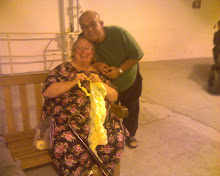It is a rainy Sunday night. I just had the best Vietnamese dinner ever at Phat on Convoy St. in Kearny Mesa, same place as previously blogged. Thank you, Dare. Pho as you like it. Endless appetizers and salads. All very light. I feel just fine. Go when you can.
On Feb 27 I posted a "reciepe" for making juzu prayer beads. This following is in response to the resulting requests for information on the significance of the prayer beads, which we SGI Buddhists hold when chanting Nam Myoho Renge Kyo or when doing morning or evening prayers, called Gongyo. It is quoted from a booklet by Ed Gwin, called the Treasure Map of Life.
"The Significance Of The Prayer Beads
The basic number of beads is 108, which is said to represent the number of earthly desires which common mortals have.
The beads form a circle with two strands (1) and three strands (2) that end in tassles. These sets of two and three strands are equal distance and opposite from each other.
Where these strands are attached to the circle, there is a large bead. These large beads are called the father's bead (3) and the mother's bead (4). Both represent the Buddha.
When the beads are used, this circle is closed by crossing them once (5). This is done for one reason. When crossed, the circle is closed so that the benefits of practicing and chanting Daimoku will not fall through.
Between the father and mother's beads, there are 108 beads of the same size that represent earthly desires. You will also find four smaller beads (6). Two of them are opposite each other on either side, seven beads away from the end with the two strands of beads attached to the figure. The second set are 14 beads beyond the first set on either side.
These small beads represent the Four Leaders of the Bodhisattvas of the Earth -- Jogyo, Jyogyo, Muhengyo, and Anryugyo. These are the four virtues of the Buddha's life:
1. The True Self of the Buddha
2. The Purity of the Buddha
3. The Boundless Eternity of the Buddha, and
4. The Happiness of the Buddha.
When we use beads during Gongyo, the end of the figure eight, with the two strands, is placed over the third finger of the left hand. The end with the three strands, over the third finger of the right. They lie on the outside of the hands, which are placed together with palms and fingers touching each other.
Directly under the father's bead, is a smaller one (7). This small bead represents the essential nature of the Law, which is absolute truth, which has existed since the beginning of time.
All together, there are five strands of beads that lie outside the hands when the palms are placed together with fingers touching.
The four strands of beads (8), which have four larger beads shaped like jars, represent "ichinen sanzen" or three thousand worlds in a momentary existence, and the mutual possession of all of them. These beads, then, represent the true and essential nature of all life, which is 3,000 worlds in a momentary existence, each one of which is a perfect manifestation of cause and effect.
These beads, shaped like jars (9), are called "The Jars" in which we store the benefits we have accumulated.
The remaining single strand of ten beads (10), are the counting beads.
If you use the beads to count Daimoku, you should count the beads on only one side - going from the father's bead to the mother's bead and returning back again along the same side. Each time you do this, you should skip over the four Bodhisattva beads.
When you have done this once, you will have chanted 108 Daimoku. Each time you finish going and returning in this fashion, you slide one of the beads on the counting strand, attached to the mother bead, forward. In this way, you can count 1,080 Daimoku using the ten beads on the counting strand. " (about 20 minutes of chanting at a reasonable pace).
I hope this was helpful for those who asked for it. Detailed instructions for beading your own juzu are in the entry dated Feb 27 earlier in this blog. Note that modern Buddhists do not usually count Daimoku (Nam Myoho Renge Kyo) when chanting, I have done it only once out of curiosity and to time it. For example, today I would use a clock to determine 20 minutes of chanting, rather than counting one cycle of 10 counting beads. However, before clocks were widely available... counting beads were used in the past.
The bridal shawl is almost done, 2 rows to go. Sometime this week Heather and I will get together and bind it off using the bead clusters she created and then block it, which is a big deal. Then it will be revealed in all its shimmering, white, drapey wonderfulness. I hope.
Lilo is in the sweater drawer again. That's where she likes to hide from the rain and keep warm.
I hope you are enjoying listening to the sounds of the cars splashing through the water in the street and keeping warm and cozy on this lovely rainy night. The flowers on the hillsides need the rain so much.
Love,
Julie
Music: Chris Botti, Italia
Location: at home in San Diego


No comments:
Post a Comment